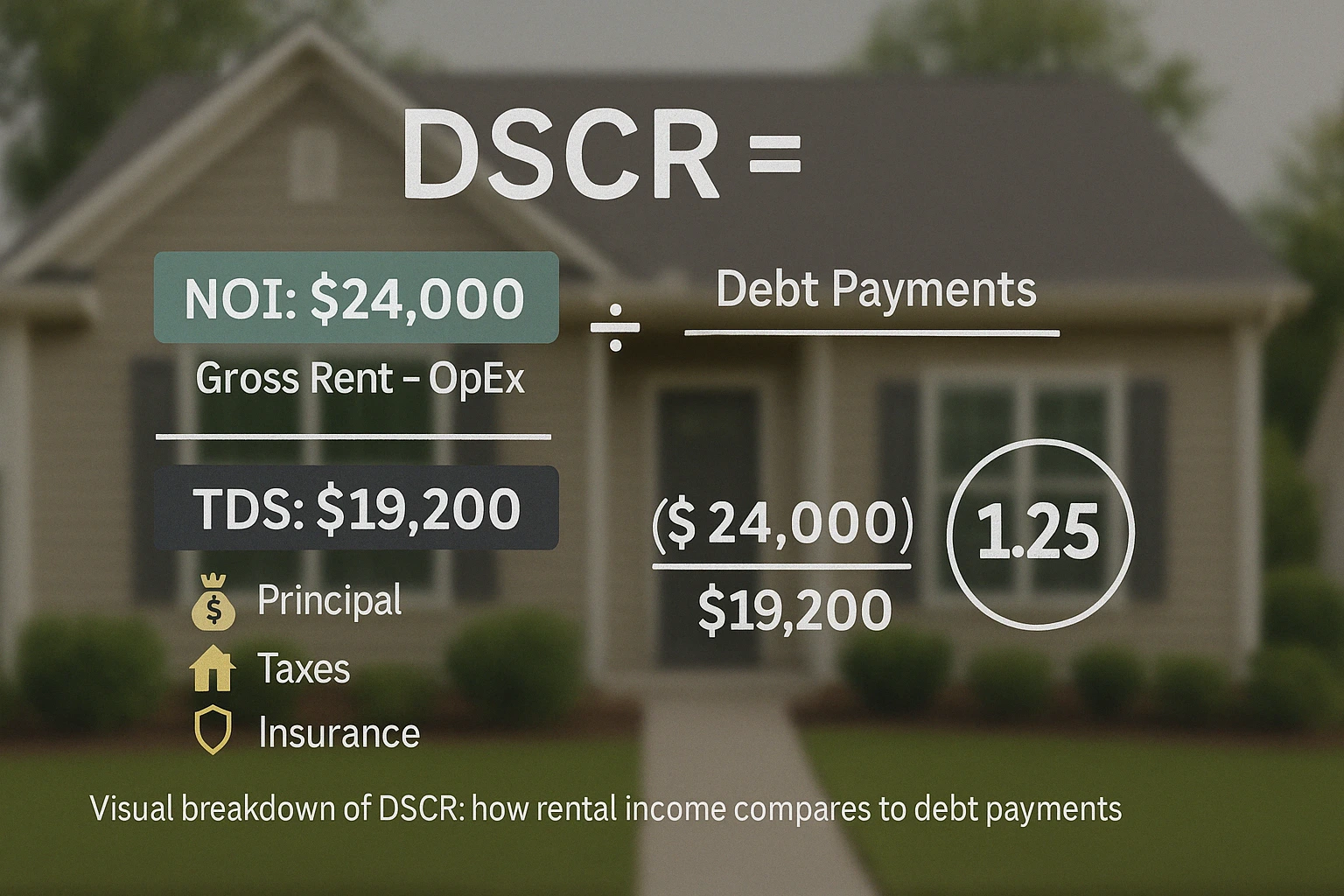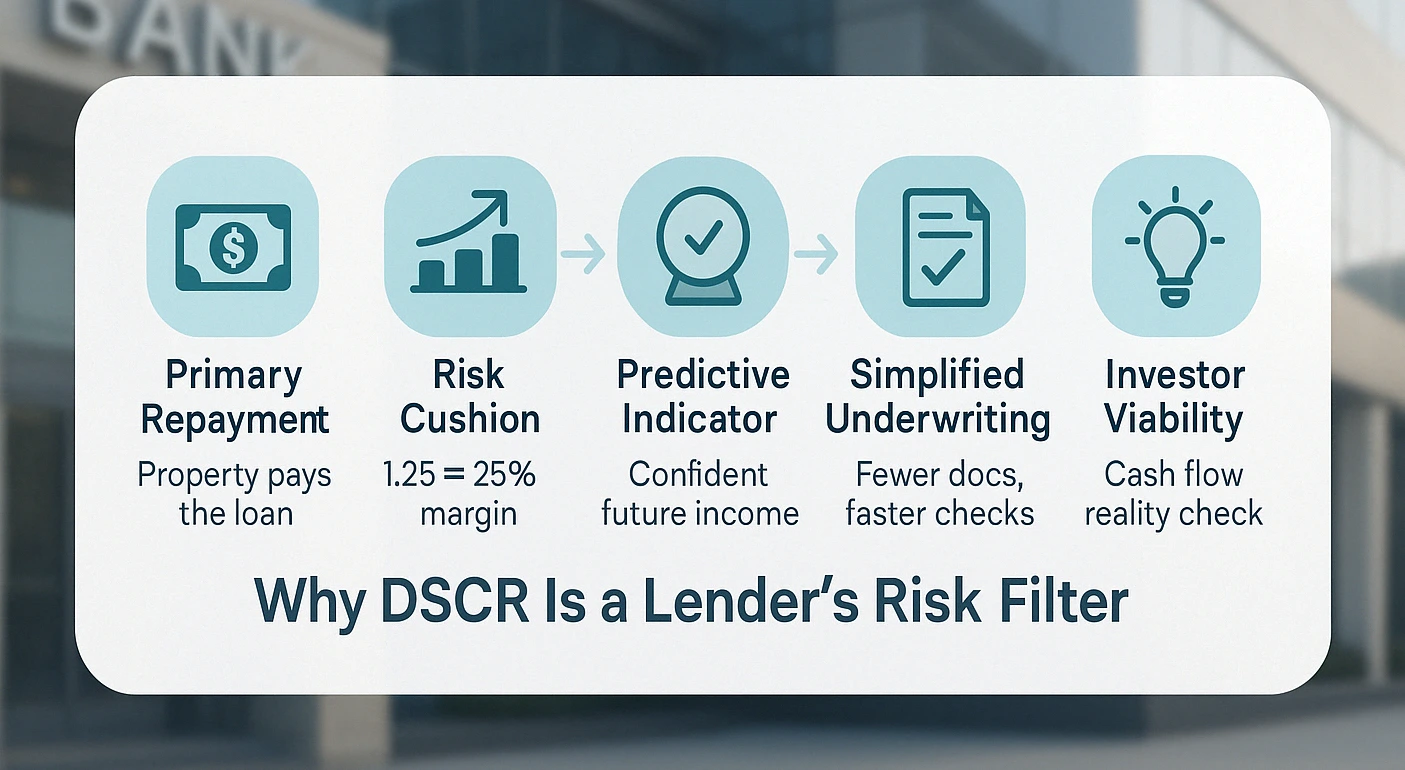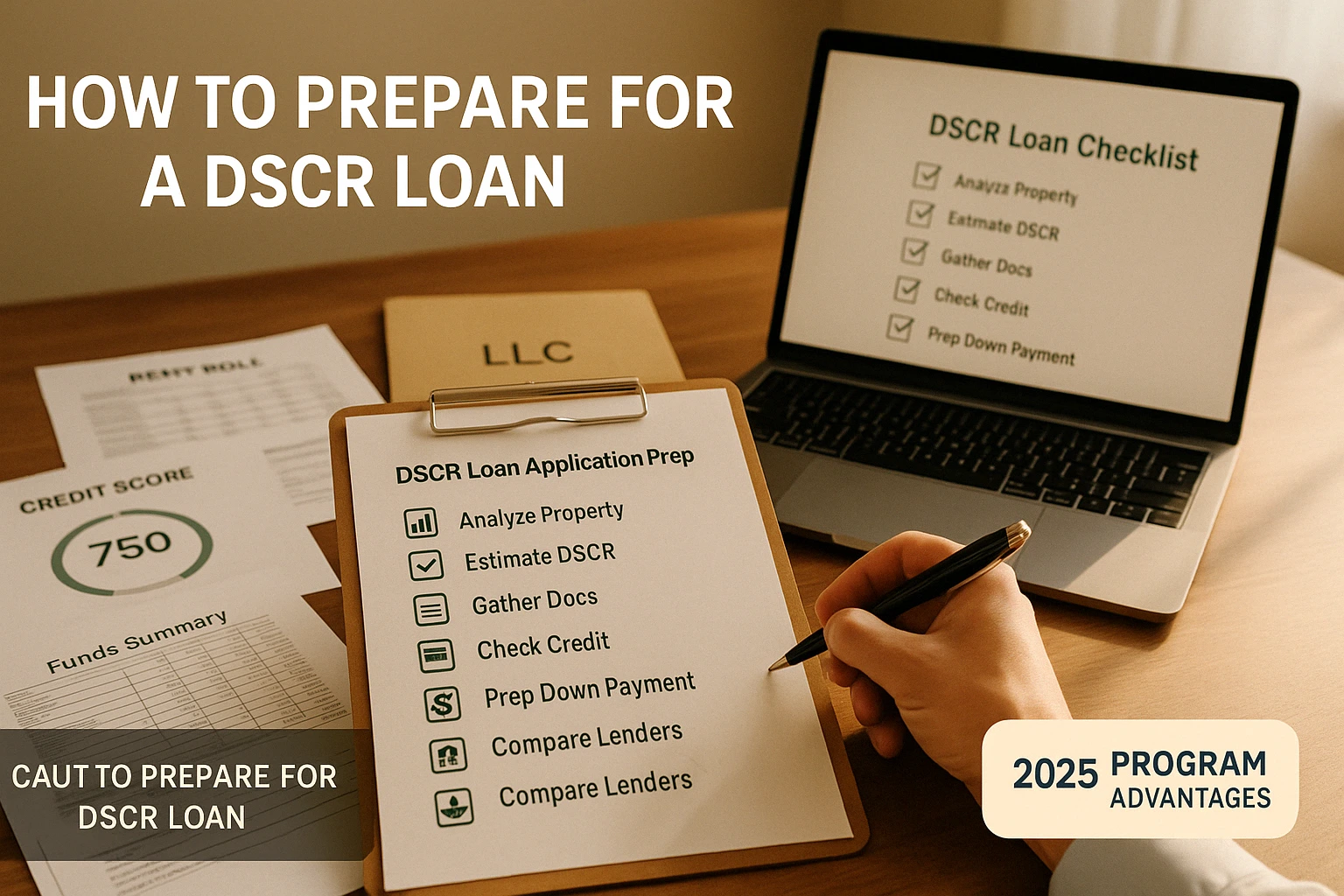
Navigating real estate investment financing can feel overwhelming, especially when traditional mortgages focus on personal income. If you’re an investor looking to acquire or refinance a rental property, understanding the DSCR loan meaning offers a unique path to success. To dive deeper into this financing option, explore our comprehensive guide on dscr loan explained.
For first-time investors, beginner real estate investors, or small business owners, grasping DSCR loans is essential. Unlike conventional loans that scrutinize W2s, tax returns, and debt-to-income ratios, DSCR loans focus on the property’s income. They ask: Can the rental property cover its debt payments?
This guide demystifies DSCR loans, breaks down their components, explains calculations with examples, and helps determine if they fit your goals. Unlock a financing alternative designed for savvy investors.
What Does DSCR Stand For?
Before diving into the DSCR loan meaning, let’s define the acronym. DSCR stands for:
Debt Service Coverage Ratio
The Debt Service Coverage Ratio measures a property’s ability to cover debt with its income. It’s a financial health check focused on cash flow, central to the DSCR loan. A higher ratio reassures lenders. Learn more at Investopedia’s DSCR page.
DSCR Loan Meaning Explained
Key Qualification Criteria
A DSCR loan is a mortgage for income-producing properties, like 1-4 unit rentals or multifamily buildings. The DSCR loan meaning hinges on its focus on the property’s Debt Service Coverage Ratio, not personal income.
Lenders assess if the property’s rental income covers mortgage payments (principal, interest, taxes, insurance – PITI). If income exceeds debt, you may qualify, even with complex finances, making it ideal for investors.
How is the DSCR Calculated?
Mastering the DSCR loan meaning requires understanding the calculation. Lenders use a formula to determine the property’s DSCR:
DSCR = Net Operating Income (NOI) / Total Debt Service (TDS)
Here’s a breakdown to clarify:
Net Operating Income (NOI)
NOI is the property’s profit before financing costs, a key part of the DSCR loan meaning. It’s calculated as:
- Gross Rental Income (GRI): Total annual rent if fully occupied, based on leases or market estimates.
- Vacancy Allowance: Subtract 5-10% of GRI for potential vacancies.
- Effective Gross Income (EGI): GRI minus Vacancy Allowance.
- Operating Expenses (OpEx): Costs like taxes, insurance, management, maintenance, utilities, and HOA dues.
Note: NOI excludes mortgage payments, depreciation, taxes, and capital expenditures.
NOI = EGI – OpEx
2. Total Debt Service (TDS)
TDS is the annual debt payments, primarily the mortgage, crucial to the DSCR loan.
- Principal & Interest (P&I): Yearly loan payments based on amount, rate, and amortization.
- Taxes & Insurance (T&I): Often included as PITI, depending on the lender.
TDS = Annual P+I (+ Taxes + Insurance, if included)
DSCR = (Gross Rental Income – Vacancy Allowance – Operating Expenses) / (Annual P+I + Taxes + Insurance)

DSCR Calculation Examples
Let’s illustrate the DSCR loan meaning with practical examples:
Scenario 1: Property with Positive Cash Flow
Property: Single-family rental
- Purchase Price: $300,000
- Down Payment (25%): $75,000
- Loan Amount: $225,000
- Interest Rate: 7.0% (30-year fixed)
- Monthly P&I: $1,496.94 (Annual P&I = $17,963.28)
- Monthly Rent: $2,800 (Annual Gross Rental Income = $33,600)
- Annual Property Taxes: $3,600
- Annual Insurance: $1,200
- Vacancy Allowance (5%): $1,680 ($33,600 * 0.05)
- Annual Operating Expenses (Maintenance, Management): $5,088 ($2,400 maintenance + $2,688 management [8% of EGI])
Calculations
- Effective Gross Income (EGI): $33,600 – $1,680 = $31,920
- Operating Expenses (OpEx): $3,600 (Taxes) + $1,200 (Insurance) + $5,088 (Maint/Mgmt) = $9,888 (Note: Taxes and Insurance included in OpEx for NOI, but separated for DSCR).
- NOI (excluding T&I): $31,920 – $5,088 = $26,832
- Total Debt Service (TDS – PITI): $17,963.28 + $3,600 + $1,200 = $22,763.28
- DSCR Calculation:
- NOI = $26,832
- TDS = $22,763.28
- DSCR = $26,832 / $22,763.28 = 1.18
Interpretation: This property’s DSCR of 1.18 means its income is 1.18 times the debt service, a positive sign for lenders. Some may require a higher ratio (e.g., 1.25).
Scenario 2: Property with Break-Even or Negative Cash Flow
Property: Single-family rental
- Annual Gross Rental Income (GRI): $26,400
- Vacancy Allowance (5%): $1,320 ($26,400 * 0.05)
- Effective Gross Income (EGI): $26,400 – $1,320 = $25,080
- Operating Expenses (Maint/Mgmt): $4,500
- NOI (excluding T&I): $25,080 – $4,500 = $20,580
- Total Debt Service (TDS – PITI): $22,763.28
DSCR Calculation
DSCR = $20,580 / $22,763.28 = 0.90
Interpretation: A DSCR of 0.90 shows the property’s income doesn’t cover debt, making it unlikely to qualify for a standard DSCR loan.
These examples highlight how rental income and expenses drive the DSCR loan meaning. Accurate projections are critical.

Why Does the DSCR Matter for Lenders?
The DSCR loan meaning emphasizes lender risk assessment. To explore which lenders prioritize this metric, check out our guide on the best DSCR lenders for 2025:
- Repayment Source: The property is the primary repayment source, not personal income.
- Risk Assessment: A DSCR above 1.0 offers a safety cushion against vacancies or downturns.
- Predictive Indicator: A strong DSCR signals ongoing debt service ability.
- Simplified Underwriting: Focusing on DSCR streamlines approval for complex incomes.
- Investor Viability: Ensures the property is a sound investment.

What is a Good DSCR?
A “good” DSCR varies by lender, but here’s a guideline to understand the DSCR loan meaning:
- DSCR < 1.0: Unacceptable; income doesn’t cover debt.
- DSCR = 1.0: Break-even; too risky for most lenders.
- DSCR > 1.0 (1.01 – 1.19): Borderline; may face stricter terms.
- DSCR ≥ 1.20 / 1.25: Good to excellent, yielding better terms.
Factors Influencing DSCR Requirements:
- Lender’s Risk Appetite: Varies by lender.
- Property Type: Multifamily may have different standards.
- Loan-to-Value (LTV): Lower LTV may allow a lower DSCR.
- Credit Score: Impacts terms despite the property focus.
- Market Conditions: Strong markets may allow flexibility.
- Interest Rates: Higher rates increase TDS, affecting DSCR.
Advantages of DSCR Loans
DSCR loans offer unique benefits for investors:
- Property Focus: Ideal for cash-flowing properties, even with complex income.
- Minimal Income Verification: No W2s or tax returns needed, a key advantage.
- Faster Closing: Less documentation can speed up the process.
- Unlimited Properties: Often no cap on financed properties.
- Entity Borrowing: Loans can be made to LLCs.
- Clear Metric: DSCR simplifies qualification.

Drawbacks of DSCR Loans
Consider these drawbacks of DSCR loans. Compare rates using our mortgage calculator:
- Higher Rates: Non-QM loans have higher interest rates.
- Larger Down Payments: Expect 20-30% minimum.
- Appraisal Emphasis: Low rent estimates can impact approval.
- Prepayment Penalties: Common for early payoff.
- Investment Only: Not for primary residences.
- Cash Flow Requirement: Properties must generate strong income.
Who Should Consider a DSCR Loan?
DSCR loans suit specific investors. For those investing in short-term rentals, explore our guide on short-term rental loans for related financing options:
- Experienced Investors: Scaling portfolios beyond conventional limits.
- Self-Employed: Those with complex income documentation.
- High DTI Borrowers: Investors with personal debt but cash.
- Foreign Nationals: Some programs cater to non-US residents.
- Entity Borrowers: Using LLCs or corporations.
- Speed Seekers: Prioritizing simpler qualification.
Who Might Not Benefit?
Not everyone benefits from a DSCR loan:
- Homebuyers: Not for owner-occupied properties.
- Fixer-Uppers: Properties needing renovations won’t qualify.
- W2 Borrowers: Conventional loans may offer better rates.
- Low-Rate Seekers: Conventional financing is cheaper.
- Low Down Payment Needs: DSCR loans require 20%+.
Preparing for a DSCR Loan Application
Aligning with the DSCR loan meaning requires preparation. Ensure you meet all DSCR loan requirements to streamline the process:
- Analyze Property: Estimate rents and expenses accurately.
- Calculate DSCR: Aim for 1.20+ using the estimator below.
- Gather Documents: Leases, rent rolls, or P&L statements.
- Check Credit: Aim for 660+ for better terms.
- Prepare Funds: Down payment and reserves (3-6 months PITI).
- Entity Documents: LLC formation, operating agreement, EIN.
- Shop Lenders: Compare rates and DSCR requirements.

Simple DSCR Estimator
Use this enhanced estimator to calculate a property’s DSCR, a key aspect of the DSCR loan meaning. Enter details or use example values to see tailored lender suggestions. Visit our tools section for more.
Simple DSCR Estimator
(For estimation only. Consult a lender for official calculations.)
| E.g., $2,800/month * 12 = $33,600 | |
| E.g., 5 for 5% | |
| C. Effective Gross Income (EGI) [A * (1 – B/100)] ($): | |
| E.g., $3,600 | |
| E.g., $1,200 | |
| E.g., $5,088 | |
| G. Net Operating Income (NOI) [C – (D + E + F)] ($): | |
| E.g., $22,763 | |
| I. Debt Service Coverage Ratio (DSCR) [G / H]: |
Frequently Asked Questions
Conclusion
Understanding the DSCR loan meaning empowers investors to finance rental properties based on absorbing cash flow, not personal income. By focusing on the Debt Service Coverage Ratio, these loans offer flexibility for complex financial situations. Use our tools section to calculate your DSCR and start your investment journey today.
Don’t Let Cash Flow Kill the Deal
Get Up to $50K in DSCR-Friendly Personal Loans